Given the proper conditions—namely lots of sun—herbs are super easy to grow and care for. As a rule, they require little maintenance and are seldom troubled by disease or pests. Indeed, most seem to thrive on benign neglect. You can use them either fresh or dried to make delicious teas, flavor soups and salads, scent your bathwater, or make potpourri. Herbs can be used to elevate your mood, lull you into a restful sleep, or repel insects. Herbs are also pretty. Many feature interesting foliage colors and textures, wonderful fragrance, and attractive flowers.
HERE IS A BASIC PRIMER ON GARDENING WITH THESE DELIGHTFUL, USEFUL, AND VERSATILE PLANTS.
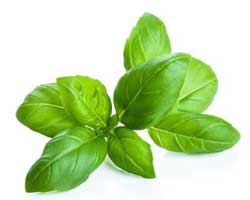
BASIL, Ocimum basilicum—This familiar, wonderfully aromatic culinary herb is an easy-to-grow annual in any sunny spot. It is readily available in scores of different varieties and is widely used in both Mediterranean and Southeast Asian cuisines. It is a must to accompany fresh tomatoes and mozzarella.

BEE BALM, Monarda didyma--This wonderful garden plant also comes in many varieties, some of which (such as the lavender-flowing Monarda fistulosa) are native to the Northeast. Its foliage is wonderfully fragrant and can be used to make a delicious bergamot-flavored tea. Its flowers, which most often appear in shades of bright scarlet or magenta, are very showy and attract hummingbirds and butterflies to the garden. Unfortunately—and unlike with most other members of the mint family and herbs in general—I have found that deer may occasionally browse this plant.
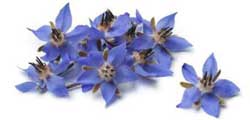
BORAGE, Borago officinalis—This is a wonderful annual to grow from seed. Sometimes called “the herb of gladness,” it is known for its mood- enhancing, exhilarating effect. It features large, crinkly leaves and lovely star-shaped pale blue flowers. Chopped young leaves and flowers can be added to salads or iced tea. Its essential oil, when sprinkled on tablecloths or napkins, is said to assure harmony at social gatherings.
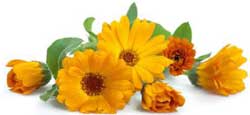
CALENDULA, Calendula officinalis—Sometimes called ‘pot marigold,’ this annual flowering herb is widely used in the cosmetics industry as a conditioner for skin and hair and as a source of natural, food-safe dyes; however, I grow it for its showy orange-yellow flowers. It is wonderful both in garden beds and containers on a sunny deck or patio. Its bright orange petals are also edible and can be used to add color and subtle flavor to salads. Like most herbs, it is deer-resistant and attracts bees and butterflies.

CATMINT, Nepeta faassenii—this is one of my absolute favorite garden plants. It features aromatic grayish green foliage and profuse lavender-blue flowers. In mid-summer after blooming, cut plants back to new growth for a repeat round of flowers. ‘Walker’s Low’ grows to about twelve-eighteen inches tall, and this clump-forming perennial is ideal for use at the front of borders and for lining pathways. It also looks great spilling over low stone walls and pavers. It is extremely deer-resistant, and when planted en masse in front of roses and other plantings, it can even discourage deer from browsing on its companions. ‘Six Hills Giant’ is a taller variety that grows two-three feet high. It is a wonderful plant for the middle of a sunny border or garden bed. Where happy, catmint also reseeds itself.
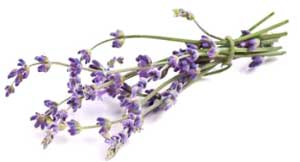
LAVENDER, Lavandula— Lavender is commonly divided into English and French groupings, but these labels are misnomers. The so-called French varieties are not the ones grown in France for the perfume industry. Here in the Hudson Valley, we are at the northern fringe of lavender’s hardiness. As such, it often does not survive our long, cold, wet winters. I usually tell clients to consider lavender as an annual but hope for the best. It especially likes to be near stone walls or pavers that help retain heat. Lavender is wonderful for edging sunny walkways or patios where brushing against the foliage will release its heavenly scent.
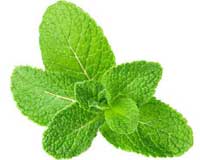
LEMON BALM, Melissa officinalis – A must for any herb garden, this perennial grows twelve-eighteen inches tall and features lush green foliage with an intense lemon scent. It is so intense, in fact, that I often joke that it reminds me of a certain brand of furniture polish. The leaves can be used in teas, soups, and salads. Where happy (which is almost anywhere in full sun to part shade), this plant will reseed itself with abandon.

MINT—Mints are a large and varied clan that include many of the plants listed in this column. However, what most consider the true mints—Mentha—are divided into two categories: spearmint (Mentha spicata) and peppermint (Mentha piperita piperita). Both share the familiar, refreshing fragrance and taste one associates with mint tea, candies, chewing gum, jellies, deserts, and sauces. Spearmint tends to be the taller of the two, often reaching over two feet in height, while peppermint tends to have a somewhat spicier taste. In addition to their fragrant and edible leaves, both also feature attractive spikes of lavender blue flowers that bees find irresistible. Use the fresh leaves of either spearmint or peppermint in your favorite salads, desserts, or beverages. Mojitos anyone? Use fresh or dried leaves for a tasty tea to lift spirits, settle upset stomachs, and aid digestion.
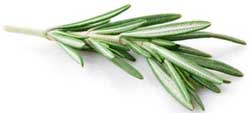
ROSEMARY, Rosmarinus officinalis—Rosemary is one of my favorite aromatic herbs, but, alas, it is not hardy here. This is one of those Mediterranean natives that favors hot, dry conditions. In such climates, it becomes a woody shrub. Use it in containers on a sunny patio near the kitchen or BBQ where you can snip its evergreen-like leaves to flavor savory dishes or to simply enjoy its wonderful fragrance. If you have a sunny south or west facing window, you can over-winter rosemary in a pot and then move it outdoors to enjoy in the spring, summer, and fall.

SAGE, Salvia officinalis—This is the familiar herb used to flavor stuffing and turkey at Thanksgiving. Aside from its culinary uses, I think it makes a lovely garden plant. It requires full sun, thrives in dry conditions and needs little care. Its fragrant gray-green foliage is very attractive, and in the spring it sports showy pink flowers. It is highly pest resistant. ‘Bergarten’ is a choice strain that features large, robust gray-green leaves. There are also multi-colored and variegated varieties; however, I have found these to be not as hardy or vigorous as the original. One of my favorite annual salvias is pineapple sage (Salvia elegans). Late in the season, it covers itself in a multitude of flaming red flowers that resemble little scarlet trumpets. Its green fragrant foliage smells strongly of pineapple and can be used to make a lovely tea. Its nectar provides a great natural food source for hummingbirds just before they migrate south for warmer climes.
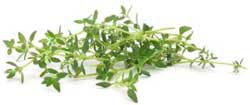
THYME, Thymus vulgaris—Depending upon the variety (of which there are many), thyme can appear either as a short, shrubby plant or a dense, creeping mat. Some types feature unusual foliage color—silvery white or yellow-gold—or fragrant hints of citrus or even rose. It is ideal for use in rockeries, lining pathways and planting between stepping stones where it can withstand light foot traffic. It can be planted en masse to resist erosion on dry, sunny slopes, and creep over low stone walls. In spring, it blooms profusely with tiny white or pink flowers that attract bees. It is a must-have herb for French cooking, and its essential oil is useful in repealing insects. It can also be used medicinally to clear sinuses and aid digestion.
This is just a small sample of the many herbs that are widely available this time of year. Useful, easy-to-grow, easy-to-maintain, and attractive, herbs should have a place in everyone’s garden. If you don’t have a garden, try growing some in a few pots on a sunny deck or balcony. You’ll be glad you did.
Eric Stewart is a garden designer, writer and artist who lives in Accord, New York. You can reach him at Greenman Garden Design, 845-687-0407, elsgreenman@aol.com or at www.greenmangarden.com. He welcomes your questions or comments.

